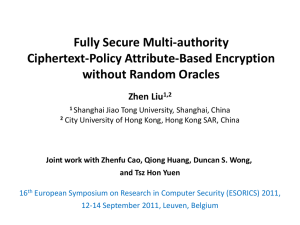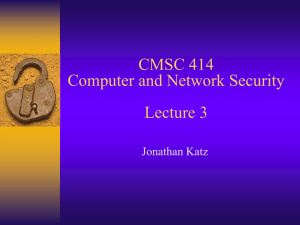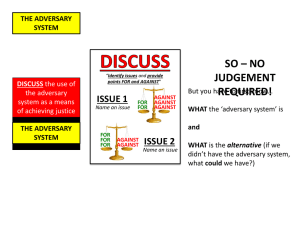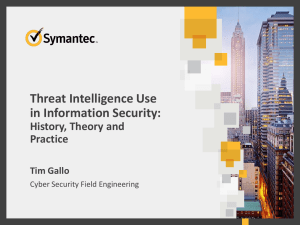Dual System Encryption: Concept, History and Recent works
advertisement
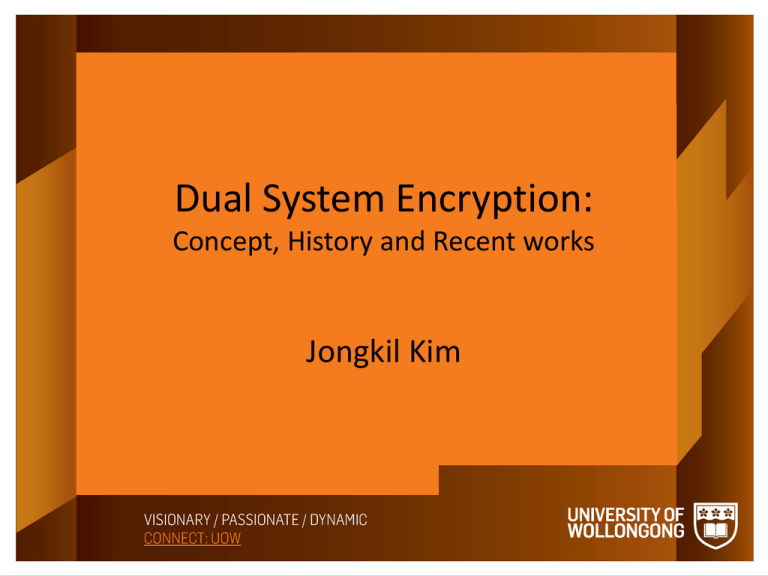
Dual System Encryption:
Concept, History and Recent works
Jongkil Kim
Introduction
• Strategy of Security Proof
• Partitioning Technique
• Dual System Encryption
– Semi-functionality
– Nominally Semi-functionality
• Encodings
• References
Strategy of Security Proof
• Claim:
Mathematical
problem is hard
Our Construction
is secure under a
security model
• Proof by contradiction
Assume that
Our
Construction is
not secure
under a
security model
Mathematical
Problem is not
hard
Strategy of Security Proof
Assume that
Our
Construction is
not secure
under a
security model
Assume there
exists an
adversary to
harm our
security model
Mathematical
Problem is not
hard
Show that our security
model equals to
mathematical hard
problem.
We can break
mathematical
hard problem
using the
adversary
Strategy of Security Proof
• “Harms the security model”?
– An adversary having non-negligible advantage to win security games.
• Notation and Definition
– X: a decryption, Y: a predicate , R: Function Between X and Y
• R(X,Y) = 1, then a key can decrypt the ciphertext. Otherwise (R(X,Y) = 0), it
does not.
• Example, in IBE, R(IDA, IDA) = 1, but R(IDA, IDB) = 0
– Public key encryption system consists of four radnomized
algorithms: Setup, KeyGen, Enc, Dec
Adaptive security model (CPA Security)
Selective
Simulator
Adversary
Y
Public key query
Setup
Phase I
Run Setup
Public key
Private key query (Xi; 𝑖 ∈ [1, 𝑞1 ] )
Run KeyGen(MSK,PP, Xi)
Private key
Challenge query (M0, M1, Y)
Challenge
B ← {0,1}
𝑠. 𝑡. 𝑌 ∉ {X i ; 𝑖 ∈ [1, 𝑞1 ]}
Run Enc(PP, MB ,Y)
Phase II
Challenge Cipehrtext
Private key query (Xi; 𝑖 ∈ [𝑞1 + 1, 𝑞])
Run KeyGen(MSK, PP, Xi)
Guess
Private key
Guess?
0 or 1
𝑠. 𝑡.
𝑌 ∉ {X i ; 𝑖 ∈ [𝑞1 + 1, 𝑞]}
Partitioning Technique
Key Space
Key Space
X1
X8
X2
X1
Phase I
Phase II
X8
X2
X9
X5
…
Y
X4
Xq
X7
X6
X10
X9
Challenge
X5
…
Y
X4
Xq
X7
X6
X10
• Partitioning the key space => Only Selective Security if
functionality of Public key scheme become complecate. (such
as ABE, IPE, Spatial Encryption ,…)
Dual System Encryption
• Introduced by Waters [Crypto 2009]
• It uses semi-functional ciphertext and semifunctional keys which are only used in the
security proof.
• In Dual System Encryption, the security of an
encryption scheme is proved by showing
following
– Semi-functional ciphertext invariance
– Semi-functional key invariance
– Semi-functional security
Semi-functionality
Decrypt?
Normal Key
Semi-functional Key
Normal Ciphertext
Yes!
Yes!
Semi-functional
Ciphertext
Yes!
No…
• We must show that two security games are invariant
– GameReal: All keys and the challenge ciphertext are normal
– GameFinal: All keys and the challenge ciphertext are semifunctional. Additionally, the message are replaced by the
random message.
– Between both, Game0, Game1, Game2,… Gameq
Semi-functional Ciphertext Invariance
• Invariance between GameReal and Game0
Adversary
Simulator
Public key query
Setup
Public key
Private key query (X)
Phase I
Private key
Challenge query (M0, M1, Y)
B ← {0,1} Semi-functional
Challenge Cipehrtext (MB)
Challenge
Phase II
Private key query (X)
Private key
Guess
Guess?
0 or 1
GameReal
≈ (Invariant)
Game0
Invariance of two games
Mathematical
Problem is hard
Assume that two
games are
indistinguishable
Assume there
exists an
adversary who
distinguishes
two games
We can break
mathematical
hard problem
using the
adversary
Show that distinguishing
two games equals to
mathematical hard
problem.
Semi-functional Ciphertext Invariance
• Invariance between Game0 and Gameq
Adversary
Simulator
Phase I
Game0
≈
Private key query (X1)
Semi-functional Private key
1
Game1
Private key query (X2)
Semi-functional Private key
2
Game2
≈
…
Challenge query (M0, M1, Y)
B ← {0,1} Semi-functional
Challenge Cipehrtext (MB)
Challenge
…
…
Phase II
Private key query (Xq)
Semi-functional Private key
q
≈
Gameq
Semi-functional Key Invariance
• Semi-functional Key Invariance
– Mathematical Induction
• We already showed Game0 is invariant with GameReal
• We now show Gamek is invariant with Gamek-1
– This is a critical part of the security proof because
the relation between kth key and challenge
ciphertext is changed.
– We must proof the normal key which can decrypt
the normal CT is indistinguishable from the semifunction key which cannot.
Semi-functional Key Invariance
• Invaraiace between Gamek-1 and Gamek
Assume there
exists an
adversary who
distinguishes
two games
Show that distinguishing
two games equals to
mathematical hard
problem.
We can break
mathematical
hard problem
using the
adversary
No limitation for the simulator in the security model!
+ The simulator can distinguish the
kth key by generating valid semifunctional ciphertext for kth key and
trying to decrypt it with the kth key.
Dual System Encryption
• How to prevent this paradox
– In Waters’ construction,
– If the simulator generate the semi-functional
ciphertext to distinguish Tagc must be equal to Tagk.
• Tagc = F(IDY) = A·IDY + B
• Tagk = F(IDX) = A·IDX + B
– But, this is hidden by pair wise independent argument
because IDX does not equal to IDY if A and B are
initially information theoretically hidden.
Nominally Semi-functionality
• Introduced by Lewko and Waters[TCC 2010]
• Similar with Water’s Construction
– If the simulator generates a semi-functional
ciphertext for testing whether kth key is semifunctional or normal, semi-functional part is going
to be cancel out.
• So, kth key is nominally semi-functional
because it can decrypt the semi-functional
challenge ciphertext.
How to hide the Nominality
• We also must show that this nominally semi-functional
key is invariant with Semi-functional key.
• In other words, we must show that the correlation
between semi-functional parts in the nominally semifunctional key and the challenge ciphertext is hidden.
• By using following
– Pair wise independent
– n-wise independent
– Linearly independent
– Information Theoretically Hidden
Maybe there are some more but not so many!
Hidden Lemma
• General Lemma for semi-functional key
invariance
Assume there
exists an
adversary who
distinguishes
Gamek-1 and
Gamek
We can break
mathematical
hard
problem(SD)
using the
adversary
• But, this is the abstract of two lemmas
Nominally Semi-functionality
• IBE in composite order
– KeyGen(PP, MSK, ID) -> SKID = {K1, K2}
• K1:= g1α + r(A ID + B) Z1, K2:= g1 r Z2
– Enc(PP, ID) -> CTID = {C, C1, C2}
• C:= M · e(g1, g1)αs, C1:= g1 s, C2:= g1 s(A ID +B)
– SFKeyGen(PP, MSK, ID) -> SKID = {K1, K2}
• K1:= g1α + r(A ID + B) g2r’a Z1, K2:= g1 r g2 r’ Z2
– SFEnc(PP, ID) -> CTID = {C, C1, C2}
• C:= M · e(g1, g1)αs, C1:= g1 s g2 s’, C2:= g1 s(A ID +B) g2 s’ b
Hidden Lemmas
• Let Gamek’ is the game identical with Gamek-1 ,
but the kth key is nominally semi functional.
Assume there
exists an
adversary who
distinguishes
Gamek-1 and
Gamek‘
We can break
mathematical
hard problem
using the
adversary
NSFKeyGen(PP, MSK, ID) -> SKID = {K1, K2}
K1:= g1α + r(A ID + B) g2r’(A’ ID + B’) Z1, K2:= g1 r g2 r’ Z2
SFEnc(PP,ID) -> CTID = {C, C1, C2}
C:= M · e(g1, g1)αs, C1:= g1 s g2 s’, C2:= g1 s(A ID +B) g2 s’ (A’ ID +B’)
Hidden Lemmas
• Let Gamek’ is the game identical with Gamek-1 ,
but the kth key is nominally semi functional.
Assume there
exists an
adversary who
distinguishes
Gamek‘ and
Gamek
We can break
information
theoretically
hidden
argument using
the adversary
NSFKeyGen(PP, MSK, ID) -> SKID = {K1, K2}
K1:= g1α + r(A ID + B) g2r’(A’ IDa +B’)Z1, K2:= g1 r g2 r’ Z2
SFEnc(PP, ID) -> CTID = {C, C1, C2}
C:= M · e(g1, g1)αs, C1:= g1 s g2 s’, C2:= g1 s(A ID +B) g2 s’ (A’ IDb+ B’)
Why this is possible?
• The semi-functional parts of private key and
ciphertext are just twins of their normal parts
• But, why is applying information hidden
argument possible?
Public key and other semifunctional keys does not reveal
any information about the semifunctional parts!
Semi-functional Security
• Invariance between Gameq and GameFinal
Adversary
Simulator
Setup
Phase I
Public key query
Public key
Private key query (X)
Semi-functionalPrivate key
Challenge query (M0, M1, Y)
R: RandBmessage
← {0,1} Semi-functional
Challenge Cipehrtext (MRB)
Challenge
Phase II
Guess
Private key query (X)
Semi-functional Private key
Guess?
0 or 1
Gameq
≈ (Invariant)
GameFinal
DSE via Encodings
• Pair Encoding [Eurocrypto 2014] and Predicate Encoding
[TCC 2014]
– Many public key schemes proved by Dual System
Encryption share a same proof strategy.
– It means it can be formalized! => New direction of the
security proof!
• We only need our new scheme satisfy following
properties
– Linearity
– Parameter Vanishing
– Perfect Master key hiding
DSE via Encoding
• Linearity
– K(α’;x,h,r’) + K(α’’;x,h,r’’)
= K(α’ +α’’;x,h,r’+r’’)
• Parameter vanishing
– K(α;x,h,0) = K(α;x,h’,0)
• Perfect master key hiding
– Given c(s;y,h), for all α, α’,
If R(x,y)=0, K(α;x,h,r) and K(α’;x,h,r) are statistically
invariant.
Encoding example (IBE)
• Construction
– Setup(λ) -> N = p1p2p3, PP = { g1A, g1B }, MSK = {α, X3}
– KeyGen(PP, MSK, ID) -> SKID = {K1, K2}
• K1:= g1α + r(A ID + B) Z1, K2:= g1 r Z2
– Enc(PP, ID) -> CTID = {C, C1, C2}
• C:= M · e(g1, g1)αs, C1:= g1 s, C2:= g1 s(A ID +B)
– Dec(SKID, CTID)
• M = C · e(K2, C2)/e(K1, C1)
Encoding example
• Encoding
– K(α;ID,(A,B),r) = (α + r(A ID + B), r)
– c(s;ID,(A,B)) = (s, s(A ID + B))
• Linearity
– (α+ r(A ID + B), r) + (α’ + r’(A ID + B), r’)
=(α + α’ + (r+r’) (A ID + B), r+r’)
• Parameter vanishing
– (α+ 0 (A ID + B), 0) + (α + 0(A’ ID + B’), 0)
Encoding example
• Encoding
– K(α;ID,(A,B),r) = (α + r(A ID + B), r)
– c(s;ID,(A,B)) = (s, s(A ID + B))
• Perfect Master key hiding
– Given (s, s(A ID* + B))
– For ID which does not equal to ID*, A ID + B is
randomly distributed (pairwise independent).
– Hence, (α + r(A ID + B),r) is statistically invariant with
(α’ + r(A ID + B),r) to the adversary
References
• [Eurocrypto 2014] N. Attrapadung. Dual system encryption via
doubly selective security: Framework, fully secure functional
encryption for regular languages, and more. In P. Q. Nguyen and E.
Oswald, editors, EUROCRYPT, volume 8441 of Lecture Notes in
Computer Science, pages 557{577. Springer, 2014.
• [Crypto 2009] B. Waters. Dual system encryption: Realizing fully
secure ibe and hibe under simple assumptions. In S. Halevi, editor,
CRYPTO, volume 5677 of Lecture Notes in Computer Science, pages
619{636. Springer, 2009.
• [TCC 2014] H. Wee. Dual system encryption via predicate encodings.
In Y. Lindell, editor, TCC, volume 8349 of Lecture Notes in Computer
Science, pages 616{637. Springer, 2014.
• [TCC 2010] A. Lewko and B. Waters. New techniques for dual
system encryption and fully secure hibe with short ciphertexts. In
TCC, 2010.

